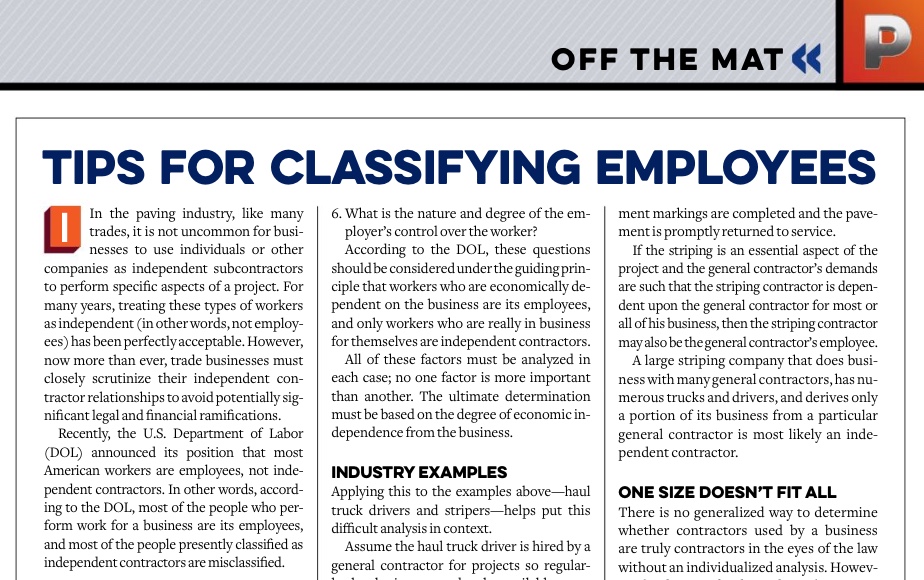Tips to Properly Classify Your Employees
BY Jeremy Brenner

In the paving industry, like many trades, it is not uncommon for businesses to use individuals or other companies as independent subcontractors to perform specific aspects of a project. For example, a haul truck driver who delivers hot-mix asphalt from the plant to the commercial job site may be considered an independent subcontractor. The striper might also be considered an independent subcontractor.
For many years, treating these types of workers as independent (in other words, not employees) has been perfectly acceptable. However, now more than ever, trade businesses must closely scrutinize their independent contractor relationships to avoid potentially significant legal and financial ramifications.
Recently, the U.S. Department of Labor (DOL) announced its position that most American workers are employees, not independent contractors. In other words, according to the DOL, most of the people who perform work for a business are its employees, and most of the people presently classified as independent contractors are misclassified.
Changes underway
In recent years, courts around the country have developed various versions of a multi-factored economic realities test to determine whether a worker is properly classified as an independent contractor under the law.
Simultaneously, the Internal Revenue Service developed its own twenty-factor test for this purpose.
By applying these tests correctly, the DOL has determined most workers would be classified as employees. In other words, a worker is an employee unless a convincing argument can be made that the worker is properly classified as an independent contractor.
Although the economic realities test might vary somewhat depending on the state and court (or the IRS) applying the test, there is some consistency:
1. Is the work done by the worker an integral part of the employer’s business?
2. Does the worker’s managerial skill affect the worker’s opportunity for profit or loss?
3. How does the worker’s relative investment compare to the employer’s investment?
4. Does the work performed require special skill and initiative?
5. Is the relationship between the worker and the employer permanent or indefinite?
6. What is the nature and degree of the employer’s control over the worker?
According to the DOL, these questions should be considered under the guiding principle that workers who are economically dependent on the business are its employees, and only workers who are really in business for themselves are independent contractors.
All of these factors must be analyzed in each case; no one factor is more important than another. The ultimate determination must be based on the degree of economic independence from the business.
Industry examples
Applying this to the examples above—haul truck drivers and stripers—helps put this difficult analysis in context.
Assume the haul truck driver is hired by a general contractor for projects so regularly that he is expected to be available every weekday at 6 a.m. at the plant to pick up the mix and take it to the site of the day. The driver is required to have his own insurance for his truck, but he’s expected to cater to the general contractor’s needs.
The driver’s work is integral to the general contractor’s business. If the general contractor exercises a high degree of control over the driver, the relationship between the general contractor and the driver is indefinite, and the driver’s commitments to the general contractor are so extensive that the driver has virtually no ability to perform work for other general contractors, the driver may actually be the general contractor’s employee under the law.
Similarly, assume the striping contractor provides his own small trailer, work truck and self-propelled line striper. Under his agreement with the general contractor, the striping contactor is responsible for maintaining the equipment, and stocking paint tips, stencils of all shapes and sizes for proper markings, and 5-gallon buckets of state-DOT-approved paint so there are no critical malfunctions that stop the job. The striping contractor is also expected to be on the job site the moment asphalt has been compacted or the moment sealer has dried so pavement markings are completed and the pavement is promptly returned to service.
If the striping is an essential aspect of the project and the general contractor’s demands are such that the striping contractor is dependent upon the general contractor for most or all of his business, then the striping contractor may also be the general contractor’s employee.
A large striping company that does business with many general contractors, has numerous trucks and drivers, and derives only a portion of its business from a particular general contractor is most likely an independent contractor. Conversely, a one-man striping business that derives most or all of its work from a single general contractor is a much closer call.
One size doesn’t fit all
There is no generalized way to determine whether contractors used by a business are truly contractors in the eyes of the law without an individualized analysis. However, the degree of independence between a business and a contractor is a key indicator.
Businesses that misclassify employees as independent contractors may be subject to, at a minimum, IRS and DOL investigations, private lawsuits for double damages going back up to three years, plus attorneys’ fees and tax penalties. As the DOL focuses on this issue, businesses will increasingly find themselves subject to scrutiny over their contractor classifications. It’s imperative that businesses get their classifications right before it’s too late.
Jeremy M. Brenner, Esq.
Attorney
Armstrong Teasdale LLP
(314) 342-4184
Jbrenner@ArmstrongTeasdale.com
Jeremy Brenner exclusively counsels and represents employers in matters pertaining to their workforces, including wage and hour, harassment, discrimination, tort, and contract claims, non-compete disputes, and labor matters. Brenner practices nationwide and represents businesses of all sizes, from “mom and pop” businesses to Fortune 100 corporations.
